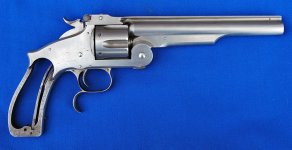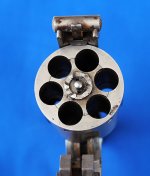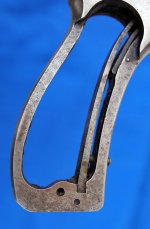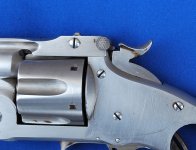You are using an out of date browser. It may not display this or other websites correctly.
You should upgrade or use an alternative browser.
You should upgrade or use an alternative browser.
Toolroom 2nd Model No. 3
- Thread starter jleiper
- Start date
Register to hide this ad
shotgun693
Member
Any documentation with it?
jleiper
US Veteran, SWCA Member, Absent Comrade
Yes, lots. Affidavit from the great grand son of King and other information. I don't even have all of it yet.Any documentation with it?
Joe
shotgun693
Member
That's a great find, one of those guns that ought to be on loan to a Museum. A great piece of History.
jleiper
US Veteran, SWCA Member, Absent Comrade
Yes, fits into my collection perfectly.
Joe
Joe
ngc2121
Member
That is one FINE piece of firearm history you got there!!!! LOVE IT!!!!!!
Last edited:
scooter123
Member
I'm curious about the finish, is that in White or is it a brushed nickle finish. The lack of corrosion on a revolver this old would be almost unbelievable for it's age but a brushed nickle finish at this time was about 100 years ahead of the curve.
jleiper
US Veteran, SWCA Member, Absent Comrade
SchofieldKid
Member
This may be a dumb question, but are there any numbers or markings that may not show in the photos? Reason I ask, I've seen tool room and prototype firearms (though not S&W) with numbers on them. They are sometimes serial or tool room numbers just to keep track of them while in use for development.
I'm not questioning the authenticity of this, just wondering. Thanks.
I'm not questioning the authenticity of this, just wondering. Thanks.
jleiper
US Veteran, SWCA Member, Absent Comrade
This revolver is completely unmarked. I have seen other prototype development revolvers and they were numbered or lettered.This may be a dumb question, but are there any numbers or markings that may not show in the photos? Reason I ask, I've seen tool room and prototype firearms (though not S&W) with numbers on them. They are sometimes serial or tool room numbers just to keep track of them while in use for development.
I'm not questioning the authenticity of this, just wondering. Thanks.


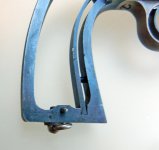
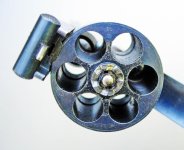
Serial 'R'
Serial 'S' is known as are Serials '1' and '2'.
Joe
I looked at it way back before Salter got it. Unfortunately, I felt there were way too many question marks and I back off of the offer to buy it.
I hope they were answered for you.
I hope they were answered for you.
jleiper
US Veteran, SWCA Member, Absent Comrade
Yes, I was able to verify what it is. It is mechanically exactly what you would see in a second model. I don't know if it is a prototype, but it is certainly a non production piece and since I collect Russian revolvers (not just S&Ws) it fits into my collection nicely. There were more than a few development stages between the first and second models, and I think it fits there.
Joe
Joe
Aussie Collector
Member
That is a great score and a one of a kind. Is there anything that places it between the different models to indicate a prototype?
Im very curious when I see these. Anyone know the story with these in the white, no serial number, guns?
Prototypes, test guns, developmental, or a tooling or template gun, maybe a gun taken from the production line and gifted as an oddball?
Im very curious when I see these. Anyone know the story with these in the white, no serial number, guns?
Prototypes, test guns, developmental, or a tooling or template gun, maybe a gun taken from the production line and gifted as an oddball?
That is a great score and a one of a kind. Is there anything that places it between the different models to indicate a prototype?
Im very curious when I see these. Anyone know the story with these in the white, no serial number, guns?
Prototypes, test guns, developmental, or a tooling or template gun, maybe a gun taken from the production line and gifted as an oddball?
Guns like these were fairly common back then. Every model that was being considered had a test gun or, a pattern made. They were used as patterns or working guns. They weren't taken out of production because they were actually preproduction models. A test gun would have been a standard production gun. Remember this is before computers. Today when a new model is being considered, all they have to do is design it on a cad systems and see if it works. There are a number of these models in the archives and some are on display at the Springfield History Museum.
You asked if it was "taken from the production line and gifted as an oddball?" It can't be an oddball if it was taken out of production. If it were gifted it would have had a number stamped on the butt.
I have a similar model that is for the .22/32 HFT's. It does have some numbers and dates on it but nothing that definitively ties it to what it is. One must remember, these guns were made and used in the "present" and there was perhaps no thought to proving to someone 100 years later what it was. 
opoefc
US Veteran
I have a tool room Model 2 Army. It is stamped "M" for Model. Measurement are identical to Serial No. 2 and later production guns. Serial No. 1 is entirely different from both the Model gun and Ser. #2 in many respects and is probably a prototype, but has all the S&W markings of later production guns, so I believe it was marked later than it was made, in order to sell it because of the high demand for the guns during the Civil War. Ed.
jleiper
US Veteran, SWCA Member, Absent Comrade
Tool room pieces are hard to identify and most collectors simply don't care and since many were not functional they were lost. I find them fascinating. The development between the first and second models clearly started long before the first contract was completed.
An early possible example is a revolver posted on this forum.
http://smith-wessonforum.com/s-w-antiques/451530-s-w-model-3-looking-info.html
There is no documentation for this revolver but the comments that are historically known indicate that the Russians were not happy with the shape of the grip on the first model. Most of this criticism seems to have come from K. Ordinets. This revolver has a grip shape that is similar to the grip shape seen on Russian manufactured Colt 1851 Navys. Since it seems to be in 44 Russian and doweled/pinned in a similar fashion to later known transitionals it definitely could be a trial/test revolver.

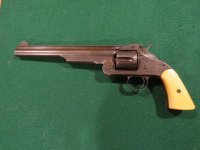
Colt 1851 Navy by Goltyakov and S&W Serial 2292.
The next example is Assy No. R which has the famous "Hack Saw Handle" grip. This is a welded and doweled/pinned example that is certainly from the tool room. It still has the features of a first model/first Russian contract revolver (square trigger with the hammer activated cylinder stop, narrow cylinder pawl and small ratchet face on the cylinder and first model style hinge screw).

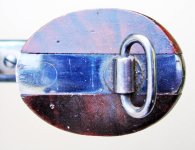

Assy No. 'R'
more ... (limited to 5 pictures)
An early possible example is a revolver posted on this forum.
http://smith-wessonforum.com/s-w-antiques/451530-s-w-model-3-looking-info.html
There is no documentation for this revolver but the comments that are historically known indicate that the Russians were not happy with the shape of the grip on the first model. Most of this criticism seems to have come from K. Ordinets. This revolver has a grip shape that is similar to the grip shape seen on Russian manufactured Colt 1851 Navys. Since it seems to be in 44 Russian and doweled/pinned in a similar fashion to later known transitionals it definitely could be a trial/test revolver.


Colt 1851 Navy by Goltyakov and S&W Serial 2292.
The next example is Assy No. R which has the famous "Hack Saw Handle" grip. This is a welded and doweled/pinned example that is certainly from the tool room. It still has the features of a first model/first Russian contract revolver (square trigger with the hammer activated cylinder stop, narrow cylinder pawl and small ratchet face on the cylinder and first model style hinge screw).



Assy No. 'R'
more ... (limited to 5 pictures)
jleiper
US Veteran, SWCA Member, Absent Comrade
The next model is in a museum (Connecticut State Library?) and is commonly known. It has a "knuckle" brazed on the frame at the top of the grip and still has the squared butt similar to a first contract.
Gun fully serial numbered '1', trigger, gas collar, and barrel would date this to late 1872. Examination shows that the joint pivot lock screw hole has been filled and the backstrap “hump” is a piece of metal brazed to the frame [Pate pg. 227]
It seems that this revolver has a different shaped hammer and the new trigger activated cylinder stop.
I will load a picture of this when I find it.
The next known model is mechanically a second model and serial numbered '2'.
It has:
A. The wider cylinder pawl and larger cylinder ratchet.
B. Pointed trigger and trigger active cylinder stop
C. A hammer that has been dove tailed and a new top brazed on (it looks just like a 2nd model hammer, but is obviously fabricated)
D. 2nd model type hinge pin
E. The frame has been cut from a first model and an entirely new grip has been pinned/doweled onto it.
F. The grips are wider/thicker than a later 2nd model so the look like they are bulged.
I have pictures of this revolver, but do not have permission to post them, I will see if permission can be obtained.
The only other verifiable early 2nd model would be the tool room model just obtained. I will be taking it down and comparing it to a known early 2nd contract revolver when time allows in a few weeks.
Joe
Gun fully serial numbered '1', trigger, gas collar, and barrel would date this to late 1872. Examination shows that the joint pivot lock screw hole has been filled and the backstrap “hump” is a piece of metal brazed to the frame [Pate pg. 227]
It seems that this revolver has a different shaped hammer and the new trigger activated cylinder stop.
I will load a picture of this when I find it.
The next known model is mechanically a second model and serial numbered '2'.
It has:
A. The wider cylinder pawl and larger cylinder ratchet.
B. Pointed trigger and trigger active cylinder stop
C. A hammer that has been dove tailed and a new top brazed on (it looks just like a 2nd model hammer, but is obviously fabricated)
D. 2nd model type hinge pin
E. The frame has been cut from a first model and an entirely new grip has been pinned/doweled onto it.
F. The grips are wider/thicker than a later 2nd model so the look like they are bulged.
I have pictures of this revolver, but do not have permission to post them, I will see if permission can be obtained.
The only other verifiable early 2nd model would be the tool room model just obtained. I will be taking it down and comparing it to a known early 2nd contract revolver when time allows in a few weeks.
Joe
Similar threads
- Replies
- 3
- Views
- 284
- Replies
- 0
- Views
- 440
- Replies
- 1
- Views
- 154
Latest posts
-
-
WTB / WTT Looking for an original WW2 M7 Shoulder Holster for the 1911/ 1911A1
- Latest: Mister Heavyhand
-
-
-
-
-
-
-
-
-
-


